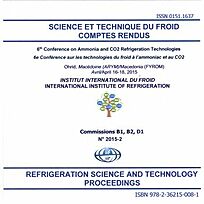
Document IIF
Borehole installations or air to water heat pumps. What to use and where.
Numéro : pap. n. 29
Auteurs : NIELSEN G.
Résumé
The use of boreholes as a low temperature heat source is spreading rapidly in Norway. There seems to be very little critical thinking whether this is an investment worthwhile or not. On the west coast of Norway we see a rapid build-up of numbers of borehole based heat pump installations, even though the climate is generally mild, and the winters usually are rather wet and grey, than crisp and white, due to the passing warm Gulf current. The typical west coast situation is an annual mean temperature of 7°C to 8°C and a design outdoor temperature of -9°C to -14°C. Even for Tromsø, as far north as 69°, with a design outdoor temperature of -15°C and an annual mean temperature of 3.4°C, there should be doubts whether borehole or air should be used as the low temperature heat source. However the use of air as heat source poses some challenges, with regard to design, especially in connection with defrosting and varying evaporation temperature. In this paper a comparison of the energy- and economic efficiency of borehole and air to water heat pump systems, located in Bergen, Karasjok, Oslo, Røros, and Tromsø is presented. The systems are calculated using two types and brands of reciprocating compressors and one screw compressor.
Documents disponibles
Format PDF
Pages : 10 p.
Disponible
Prix public
20 €
Prix membre*
15 €
* meilleur tarif applicable selon le type d'adhésion (voir le détail des avantages des adhésions individuelles et collectives)
Détails
- Titre original : Borehole installations or air to water heat pumps. What to use and where.
- Identifiant de la fiche : 30014635
- Langues : Anglais
- Source : 6th Conference on Ammonia and CO2 Refrigeration Technology. Proceedings: Ohrid, North Macedonia, April 16-18, 2015.
- Date d'édition : 16/04/2015
Liens
Voir d'autres communications du même compte rendu (53)
Voir le compte rendu de la conférence
Indexation
- Thèmes : Techniques des pompes à chaleur
- Mots-clés : Comparaison; Air-eau; Puits de forage; Pompe à chaleur; Norvège; Efficacité énergétique; Économie d'energie
-
A preliminary assessment of the effects of grou...
- Auteurs : CHIASSON A. D., REES S. J., SPITLER J. D.
- Date : 2000
- Langues : Anglais
- Source : ASHRAE Transactions. 2000 Winter Meeting, Dallas, Texas + CD-ROM.
Voir la fiche
-
Geology and the ground heat exchanger: what eng...
- Auteurs : SACHS H. M., DINSE D. R.
- Date : 24/06/2000
- Langues : Anglais
- Source : ASHRAE Transactions. 2000 ASHRAE Annual Meeting, Minneapolis, Minnesota + CD-ROM.
Voir la fiche
-
Borehole thermal resistance: laboratory and fie...
- Auteurs : REMUND C. P.
- Date : 1999
- Langues : Anglais
- Source : ASHRAE Transactions. 1999 Winter Meeting, Chicago, Illinois + CD-ROM.
Voir la fiche
-
Results of an in-situ measurement campaign on a...
- Auteurs : VOS D., JESPERS L., VANHOUDT D., et al.
- Date : 16/06/2013
- Langues : Anglais
- Source : Clima 2013. 11th REHVA World Congress and 8th International Conference on Indoor Air Quality, Ventilation and Energy Conservation in Buildings.
- Formats : PDF
Voir la fiche
-
Borehole grouting: field studies and thermal pe...
- Auteurs : SMITH M. D., PERRY R. L.
- Date : 1999
- Langues : Anglais
- Source : ASHRAE Transactions. 1999 Winter Meeting, Chicago, Illinois + CD-ROM.
Voir la fiche
